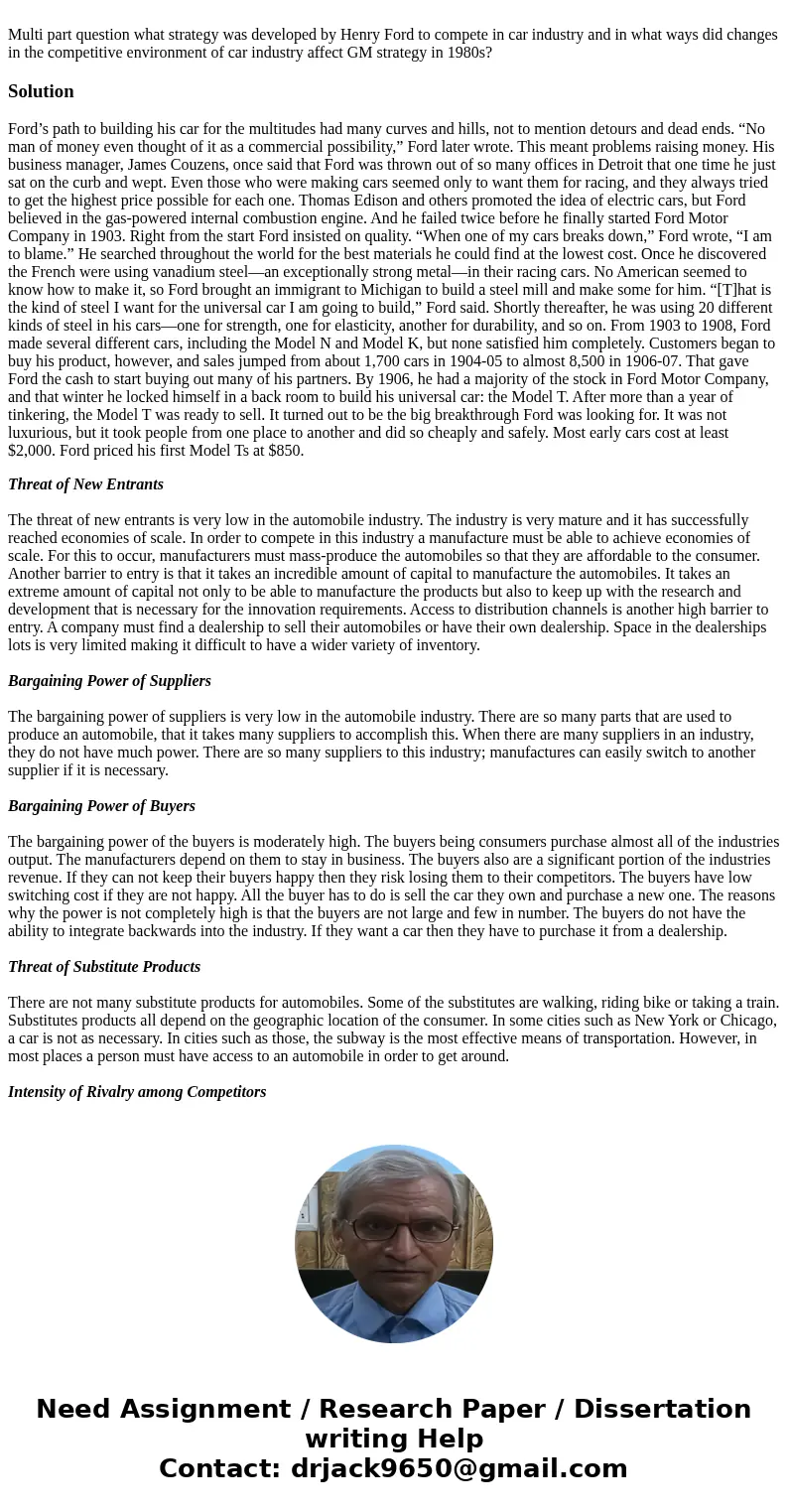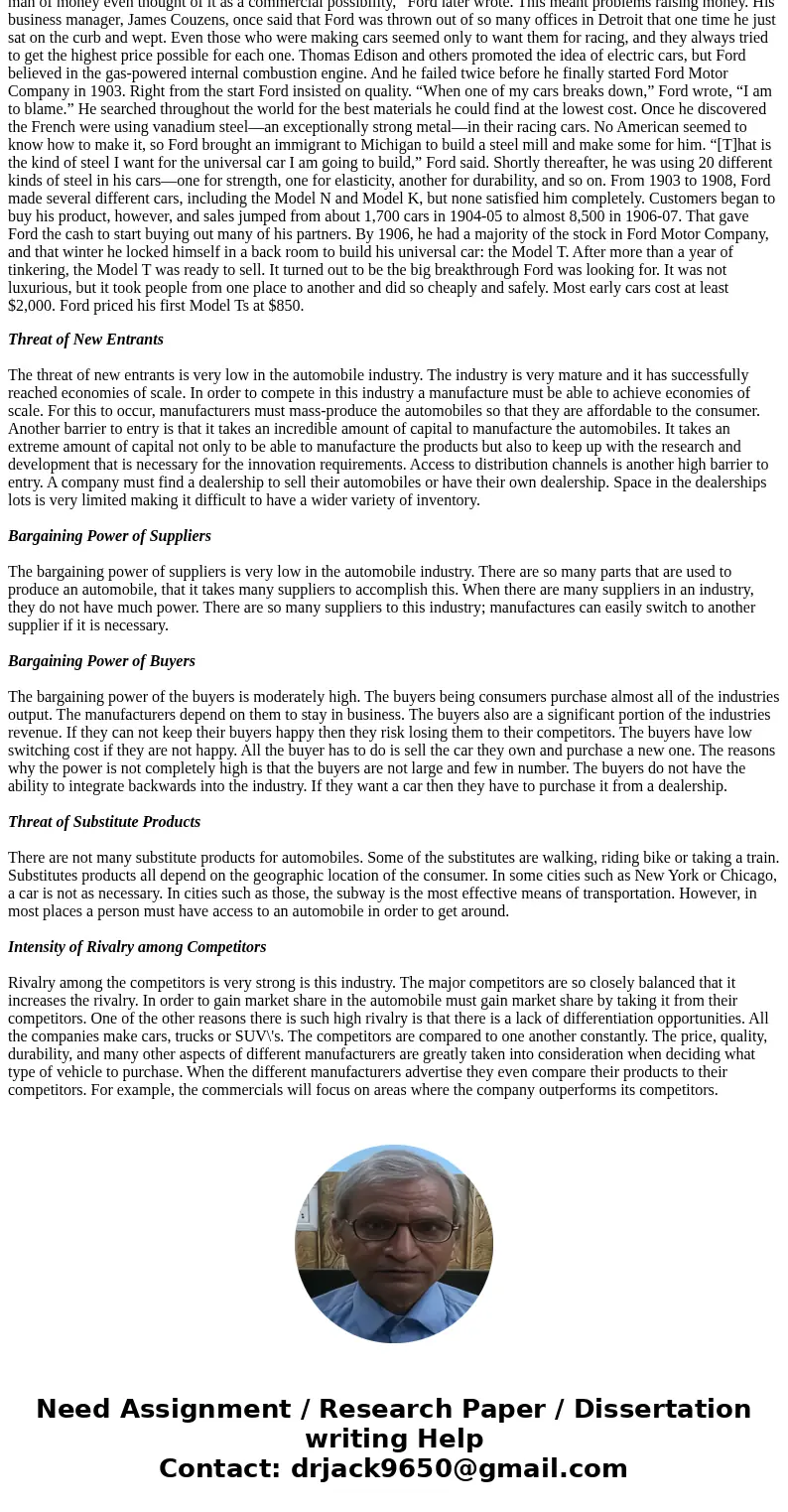Multi part question what strategy was developed by Henry For
Multi part question what strategy was developed by Henry Ford to compete in car industry and in what ways did changes in the competitive environment of car industry affect GM strategy in 1980s?
Solution
Ford’s path to building his car for the multitudes had many curves and hills, not to mention detours and dead ends. “No man of money even thought of it as a commercial possibility,” Ford later wrote. This meant problems raising money. His business manager, James Couzens, once said that Ford was thrown out of so many offices in Detroit that one time he just sat on the curb and wept. Even those who were making cars seemed only to want them for racing, and they always tried to get the highest price possible for each one. Thomas Edison and others promoted the idea of electric cars, but Ford believed in the gas-powered internal combustion engine. And he failed twice before he finally started Ford Motor Company in 1903. Right from the start Ford insisted on quality. “When one of my cars breaks down,” Ford wrote, “I am to blame.” He searched throughout the world for the best materials he could find at the lowest cost. Once he discovered the French were using vanadium steel—an exceptionally strong metal—in their racing cars. No American seemed to know how to make it, so Ford brought an immigrant to Michigan to build a steel mill and make some for him. “[T]hat is the kind of steel I want for the universal car I am going to build,” Ford said. Shortly thereafter, he was using 20 different kinds of steel in his cars—one for strength, one for elasticity, another for durability, and so on. From 1903 to 1908, Ford made several different cars, including the Model N and Model K, but none satisfied him completely. Customers began to buy his product, however, and sales jumped from about 1,700 cars in 1904-05 to almost 8,500 in 1906-07. That gave Ford the cash to start buying out many of his partners. By 1906, he had a majority of the stock in Ford Motor Company, and that winter he locked himself in a back room to build his universal car: the Model T. After more than a year of tinkering, the Model T was ready to sell. It turned out to be the big breakthrough Ford was looking for. It was not luxurious, but it took people from one place to another and did so cheaply and safely. Most early cars cost at least $2,000. Ford priced his first Model Ts at $850.
Threat of New Entrants
The threat of new entrants is very low in the automobile industry. The industry is very mature and it has successfully reached economies of scale. In order to compete in this industry a manufacture must be able to achieve economies of scale. For this to occur, manufacturers must mass-produce the automobiles so that they are affordable to the consumer. Another barrier to entry is that it takes an incredible amount of capital to manufacture the automobiles. It takes an extreme amount of capital not only to be able to manufacture the products but also to keep up with the research and development that is necessary for the innovation requirements. Access to distribution channels is another high barrier to entry. A company must find a dealership to sell their automobiles or have their own dealership. Space in the dealerships lots is very limited making it difficult to have a wider variety of inventory.
Bargaining Power of Suppliers
The bargaining power of suppliers is very low in the automobile industry. There are so many parts that are used to produce an automobile, that it takes many suppliers to accomplish this. When there are many suppliers in an industry, they do not have much power. There are so many suppliers to this industry; manufactures can easily switch to another supplier if it is necessary.
Bargaining Power of Buyers
The bargaining power of the buyers is moderately high. The buyers being consumers purchase almost all of the industries output. The manufacturers depend on them to stay in business. The buyers also are a significant portion of the industries revenue. If they can not keep their buyers happy then they risk losing them to their competitors. The buyers have low switching cost if they are not happy. All the buyer has to do is sell the car they own and purchase a new one. The reasons why the power is not completely high is that the buyers are not large and few in number. The buyers do not have the ability to integrate backwards into the industry. If they want a car then they have to purchase it from a dealership.
Threat of Substitute Products
There are not many substitute products for automobiles. Some of the substitutes are walking, riding bike or taking a train. Substitutes products all depend on the geographic location of the consumer. In some cities such as New York or Chicago, a car is not as necessary. In cities such as those, the subway is the most effective means of transportation. However, in most places a person must have access to an automobile in order to get around.
Intensity of Rivalry among Competitors
Rivalry among the competitors is very strong is this industry. The major competitors are so closely balanced that it increases the rivalry. In order to gain market share in the automobile must gain market share by taking it from their competitors. One of the other reasons there is such high rivalry is that there is a lack of differentiation opportunities. All the companies make cars, trucks or SUV\'s. The competitors are compared to one another constantly. The price, quality, durability, and many other aspects of different manufacturers are greatly taken into consideration when deciding what type of vehicle to purchase. When the different manufacturers advertise they even compare their products to their competitors. For example, the commercials will focus on areas where the company outperforms its competitors.


 Homework Sourse
Homework Sourse